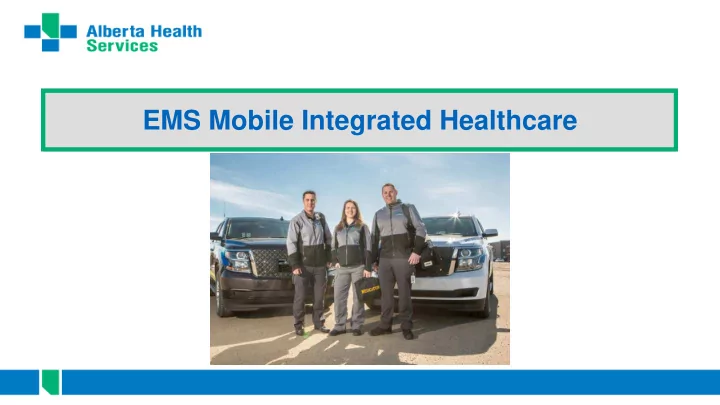

EMS Mobile Integrated Healthcare
Mobile Integrated Healthcare Purpose To serve as a single point of contact for care providers needing to refer vulnerable patients for short-term medical support. Goal Improve healthcare system capacity by reducing reliance on EMS, the emergency department and hospitals for urgent low-acuity illnesses. Model Provide medical assessments, diagnostics and treatments using mobile Community Paramedic resources, in coordination with existing healthcare services through the MIH Assess Treat and Refer program. 2
EMS and Paramedic Opportunity Anywhere, Anytime, Access to non-emergent hospital level medical care Moving patient care outside of the hospital Using the success and proven ability of EMS to provide mobile medical treatment Re-frame the Paramedic scope of practice Community Paramedics are provided with additional training and clinical rotations 3
Accessing MIH Services Access Point 1 – Community healthcare staff directly request Community Paramedic services via phone Access Point 2 – Physician or clinics request services via referral form Access Point 3 – EMS or Community referral via phone 1 300 Partners 2 Across the 3 Province Assess Treat and Refer Coordination Centre 4
Medical Direction 1. Most Responsible Healthcare Provider – Family Physician, Specialist, On-Call Facility Physician 2. MIH On-Line Medical Control (OLMC) Physician First Second Pathway Pathway Most MIH Responsible OLMC Healthcare Provider 5
Clinical Services / Interventions • Extensive medication formulary • CVC & IV rehydration available (60 + stocked) • IV, SQ, IM, PO, PORT & PICC • Urinary catheterization medication administration including IV antibiotics • Wound closure & care (tissue adhesive, sutures, dressings, • Specimen collection (blood, staples) urine, wound, NP) • Prescription facilitation • Blood transfusions • Facilitated DI transports • Medication dispensing • Healthcare System Navigation and • Point of Care Testing (iStat) Assessment 6
MIH Coordination Center First point of contact for care providers Provide EMS and Community Health staff with real- time solutions for non-emergent patients Opportunity to connect patients with community health services when they choose not to be transported Coordination centers – Edmonton (North Sector) and Calgary (South Sector) Provincial Coverage Staffed by Community Paramedics called Patient Coordinators Interface with existing dispatch services 7
Crisis Response and EMS (CREMS) - Partnership with AHS AMH and AHS EMS - Provides Medical and Mental Health Assessment to Patients Experiencing Crisis in Community - Referrals from Access 24/7, EMS, EPS, PACT, RPACT - Provides Heavy User intervention via EMS CHAPS Referrals - Responds outside City of Edmonton - Available 1200-000 Seven Days a Week 8
City Center Team (CCT) - Supports at Risk and Vulnerable Persons - Two Paramedics in Mobile Treatment Van - Provides Outreach, System Navigation and Urgent Medical Care - Facilitate Community DI - Works with Outreach Agencies and Teams - Works Monday – Friday 0730-1600 9
Community Health and Prehospital Support (CHAPS ) • Managed by MIH Coordination Center • Receive Report from EMS Paramedics for Patients Who Require Additional Support or Heavy System Users • Telephone Assessment by Community Paramedic to Patient then Referral to Community Health Agency • Works to Manage Heavy System Users and Ensure Patients Remain Safely in Community 10
Health Outcomes for Edmonton Zone MIH Zone 7 Day Admission Rate Edmonton 5% Provincial 7.6% Patient Events Avoidance rates are based on the following measures: 4581 • Administration of specific medications and blood analysis • Urinary catheterization Hospital Avoidance • EMS to CRT referrals • CTAS score 1, 2 and 3 3435 • Acute wound treatment 11
Thank You Contact Information: steven.amrhein@ahs.ca www.ahs.ca/communityEMS 12
Recommend
More recommend